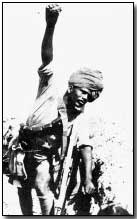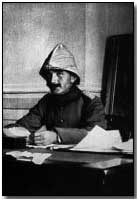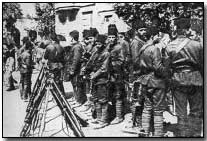Battles - The Capture of Basra, 1914
 The capture of Basra
(present-day Al-Basrah) formed the opening action on the Mesopotamian Front
and ran from 5-21 November 1914 with the belated entry of Turkey into the
war against the
Entente Powers.
The capture of Basra
(present-day Al-Basrah) formed the opening action on the Mesopotamian Front
and ran from 5-21 November 1914 with the belated entry of Turkey into the
war against the
Entente Powers.
By November 1914 the Indian government already had some 5,000 Indian Expeditionary Force D troops in the Persian Gulf under the command of General Sir Arthur Barrett, having set off from Bombay on 16 October.
Sited at the mouth of the Shatt-el-Arab and provided with support by the Royal Navy's Gulf Division Barrett's force were originally despatched to protect against territorial incursions from the then-neutral Ottoman Empire.
In particular the government in Britain was especially keen to guard Abadan and its associated pipeline to Persian oilfields. The London War Office was in favour of a cautious strategy of simply defending British oil supplies in Mesopotamia, rather than in an aggressive forward strategy.
Nevertheless the government in India, while recognising the key importance of securing continued access to the oilfields, remained in favour of what it termed 'forward defence' - in essence the ambitious policy discounted by London.
Thus Barrett's instructions included a provision - unknown to London - enabling an attack upon the Turk-controlled port of Basra in the event of formal hostilities breaking out between Britain and Turkey.
 Basra
- a city on the River Euphrates, inland from where the river flowed into the
head of the Persian Gulf - contained a population of approximately 60,000
people, comprised of a mixture of Muslims and Christians.
Basra
- a city on the River Euphrates, inland from where the river flowed into the
head of the Persian Gulf - contained a population of approximately 60,000
people, comprised of a mixture of Muslims and Christians.
With hostilities between the Ottoman Empire and the Entente Powers formally under way from 5 November 1914 the Anglo-Indian force lost no time in acting against Basra. The following day Brigadier-General Delamain (forming the advance force) despatched 600 troops to secure the poorly defended coastal batteries at Fao before moving upriver, supported by naval sloops and an armed merchant cruiser.
Reaching Abadan on 7 November Delamain's force quickly dispersed light resistance before establishing a fortified camp some 5km further up the river. Delamain repelled a dawn attack launched by 400 Turkish troops on 11 November at heavy loss to the Turks. Within the space of three days a further 7,000 Indian troops had been added to Expeditionary Force D, along with light artillery.
Barrett resolved to lose no time in taking Basra, in spite of the knowledge that a significant Turkish force of 4,500 men, operating under Subhi Bey (commander of lower Mesopotamian forces), was assembling there.
 Consequently
Barrett captured forward Turkish defensive positions at Saihan prior to
launching a full-scale attack on 19 November.
Consequently
Barrett captured forward Turkish defensive positions at Saihan prior to
launching a full-scale attack on 19 November.
In the face of distinctly unfavourable attacking conditions - heavy rainfall and its consequent mud bath, in addition to heat mirages - the British force found progress initially difficult to come by until the use of 18-pounder artillery succeeded in scattering defenders, most of whom escaped under protection of a heat mirage, unable to be pursued by cavalry in such thick mud.
Defeated in action the Turks hurriedly attempted to initiate a prepared plan to close the Shatt-el-Arab by tying a string of ships across it and sinking them. However a cable snapped leaving a gap sufficient to enable one British vessel at a time to pass through.
The following morning Barrett received news from a local Arab Sheikh that the Turks had withdrawn leaving Basra empty. Thus two battalions embarked and sailed to Basra entering the city on the evening of 21 November; Barrett officially took possession two days later.
In taking Basra the British-led force suffered under 500 casualties and the Turks in excess of 1,000. Crucially the British had secured and ensured a continuation of oil supplies in the Middle East: a matter of paramount importance.
Misled by the apparent fragility of Turkish defences into assuming this to be the case generally, the Indian administration felt sufficiently encouraged to determine to extend Anglo-Indian operations further beyond expectations previously established in London.
Click here to view a map charting operations in Mesopotamia through to 1917.
Photographs courtesy of Photos of the Great War website
A 'flying pig' was a mortar bomb.
- Did you know?
